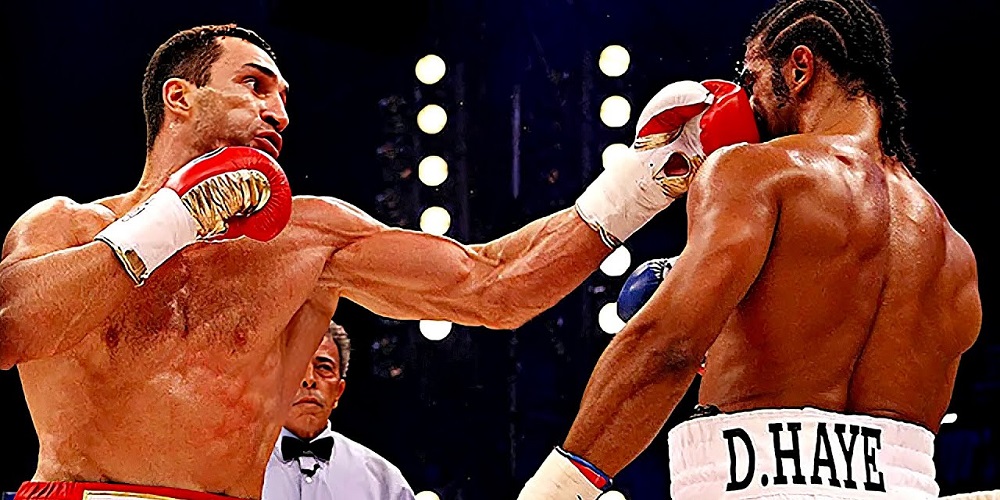It’s been exactly 13 years since one of the most majestic and significant performances of Wladimir Klitschko’s long reign. On July 2, 2011, the Ukrainian giant displayed an authentic domination in front of a packed crowd at Hamburg’s Imtech Arena against what many critics considered his most dangerous opponent in years, the charismatic English fighter David Haye. The numerous provocations of “Hayemaker,” which had characterized the long build-up to the fight, ended in a resounding failure, consecrating Klitschko as the unified WBO, IBF, and WBA heavyweight champion of the world, as well as the worthy dominator of his era. Let’s revisit that highly anticipated fight on its anniversary to recount what happened in Hamburg that night.
Severed Heads and a Denied Handshake: Haye’s Psychological Strategy
When David Haye announced his move to the heavyweight division after unifying three world titles in the cruiserweight class, fans worldwide immediately began to look forward to a showdown with one of the Klitschko brothers. At the time, the heavyweight category was experiencing a period of low appeal: the two Ukrainian giants were easily and effortlessly dispatching all challengers, and having promised their mother they would never fight each other, they left heavyweight enthusiasts without the spectacles they longed for. Wladimir’s overly conservative and cautious style, which he adopted after early career knockouts, frustrated many fans who wanted to see him finally face an opponent with top-notch offensive skills.
With his extraordinary explosiveness, David Haye seemed to fit the desired profile, and the news of a signed contract between the two in 2009 was met with enthusiasm and curiosity. However, the former cruiserweight champion “played hard to get”: he backed out of the fight at the last moment, started negotiations with Vitali, and eventually chose to face the more manageable Nicolai Valuev, claiming the WBA title with a lackluster points victory. When Haye and Wladimir finally reached a definitive agreement in 2011, Klitschko was determined to punish his rival’s insolence: the English boxer had repeatedly appeared in public wearing a shirt depicting himself holding the severed heads of the Klitschko brothers and had also refused handshakes during press conferences. These actions were perhaps part of a psychological strategy aimed at pushing Klitschko into a reckless all-out fight.
Great Expectations Unmet in the Ring
The thrilling fight eagerly anticipated by fans, who had long been deprived of excitement in the heavyweight division, never materialized. Yet, expectations were sky-high: more than 60,000 people watched the fight live, and it’s estimated that around 500 million viewers saw the fight via various broadcasting channels. However, it’s likely that many were disappointed, and the main responsibility for the lack of spectacle lies with David Haye’s strategy that night.
Convinced he could capitalize on a mistake by his opponent, punishing him with one of his renowned counter punches and winning by KO, the English boxer employed an extremely elusive tactic, moving frantically along the ropes, constantly giving up the center of the ring to Klitschko, and waiting for the opportune moment to land the decisive blow. However, the Ukrainian’s swift footwork proved to be a perfect antidote, completely nullifying Hayemaker’s plans. Wladimir pressed decisively but always maintained the right distance to land his jab and then move out of range, rendering Haye’s punches consistently ineffective.
It seems paradoxical in hindsight that before the fight, Haye’s trainer Adam Booth insisted that referee Genaro Rodriguez should not allow Klitschko to excessively hold: by systematically avoiding close quarters and fleeing for most of the twelve rounds, the WBA champion rendered Wladimir’s obstructive tactics virtually unnecessary. Booth’s demands likely had some impact, as Rodriguez was quite strict, penalizing Klitschko in the seventh round for some seemingly minor pushes. Haye tried to capitalize on this, falling at every minor contact, but ended up irritating the referee, who grew so impatient that he counted the Englishman down after another fall in the eleventh round.
There’s little to recount about the content of the fight, as the rounds followed a nearly identical pattern. Haye achieved some minor success with his notorious wide right hand only occasionally and almost always in a partial manner, enough to make some rounds in the first half of the fight somewhat balanced, but certainly not enough to keep up on points. The only real thrill, albeit very brief, came in the final round when a clean punch finally landed, stunning Klitschko for a fraction of a second and forcing him to hold. The Ukrainian, however, responded like a champion, quickly recovering and closing the fight in a strong finish, fully deserving the wide lead on the judges’ scorecards. The famous HBO commentator Larry Merchant’s caustic remark seeing Haye raise his arm after the final bell summed it up: “Why is Haye raising his arm? Maybe he’s happy that this disaster is over.” To Merchant’s microphone, the defeated fighter offered a peculiar alibi for his underwhelming performance after the verdict was announced: he claimed to have broken a toe on his right foot three weeks earlier and couldn’t put power into his punches due to the lack of push from his support leg. Fans and pundits alike unanimously dismissed this excuse as ridiculous and disgraceful, unworthy of a unification fight of such magnitude. Enormous praise was rightly given to Wladimir Klitschko, who for many years had been accused of being a champion with a glass jaw, reigning only due to the absence of notable punchers. That night in Hamburg, “Dr. Steelhammer” proved he was much more than that.

